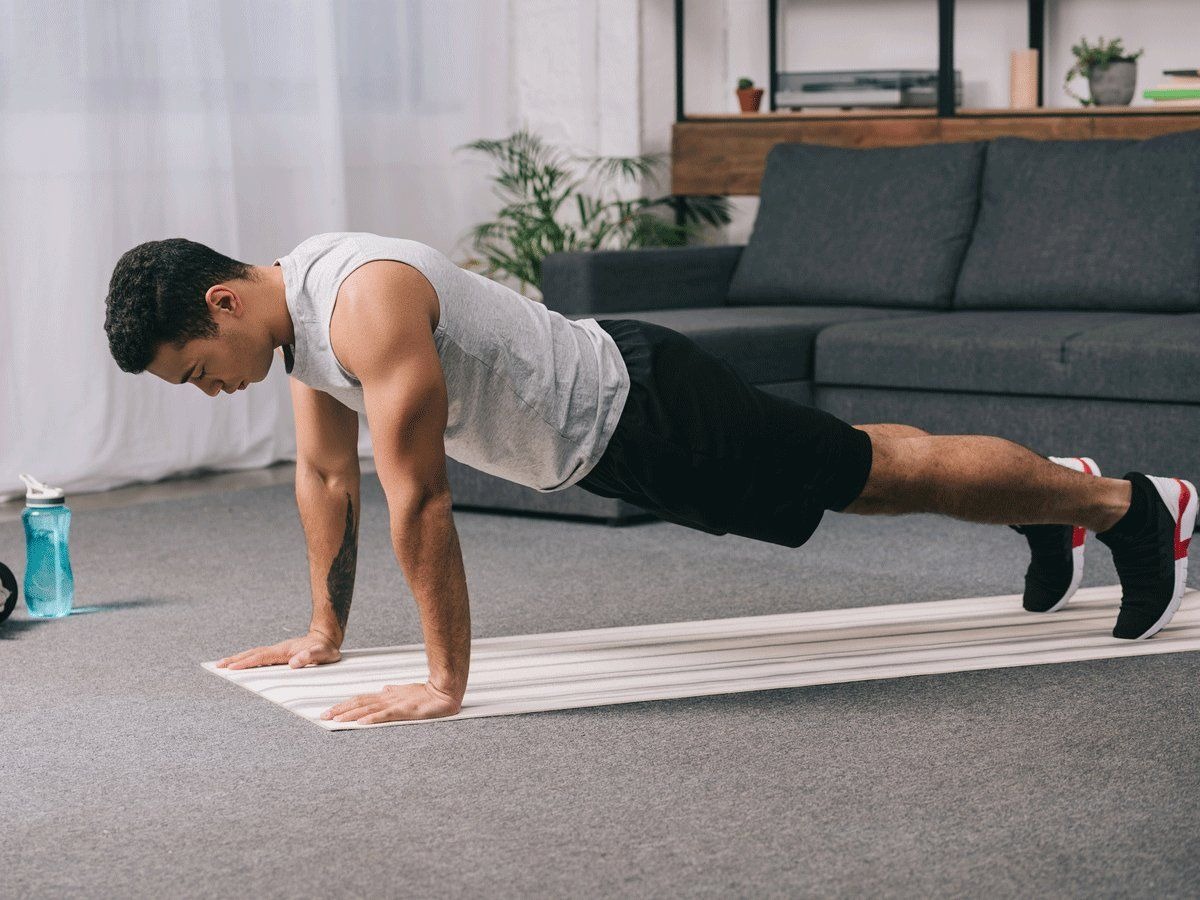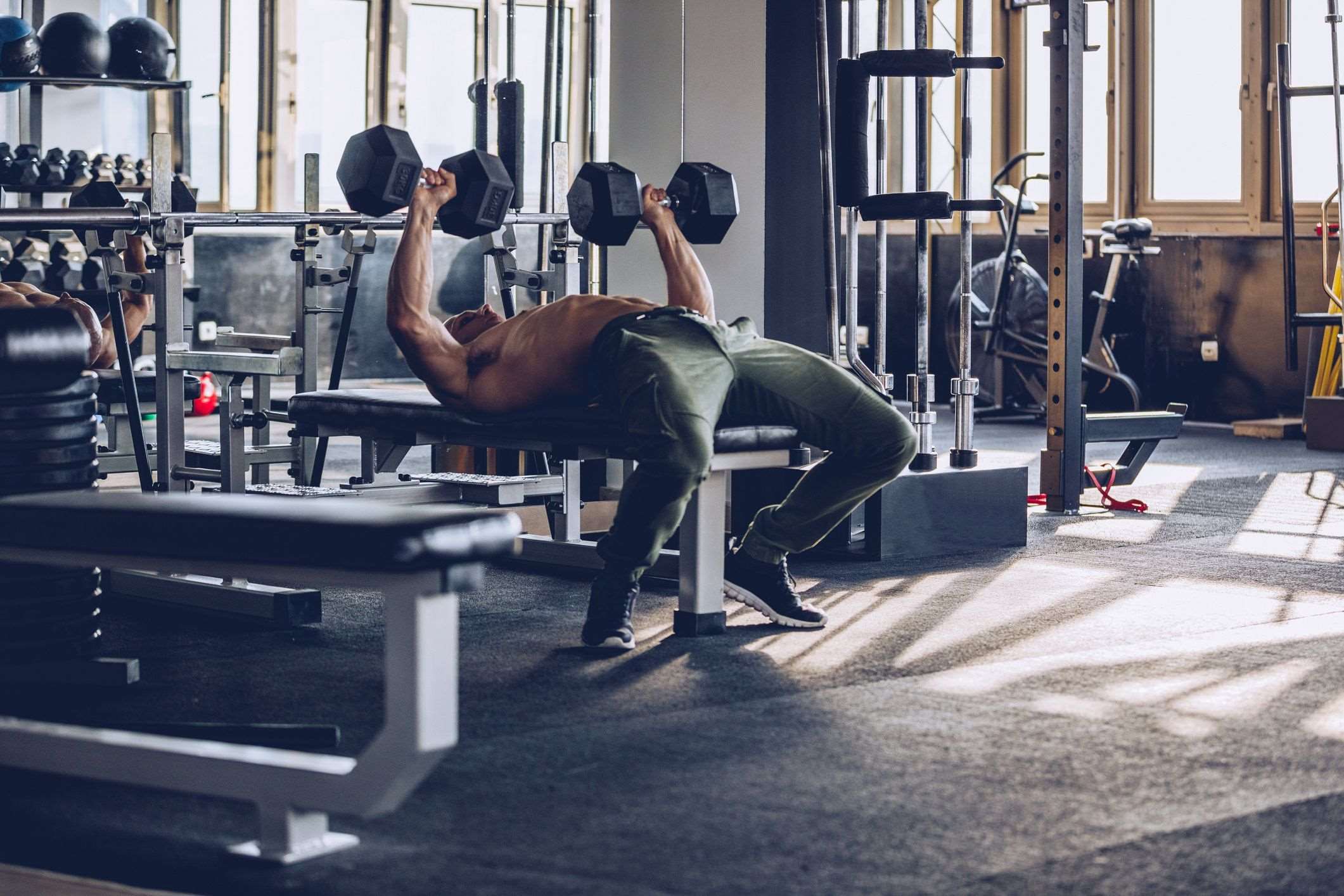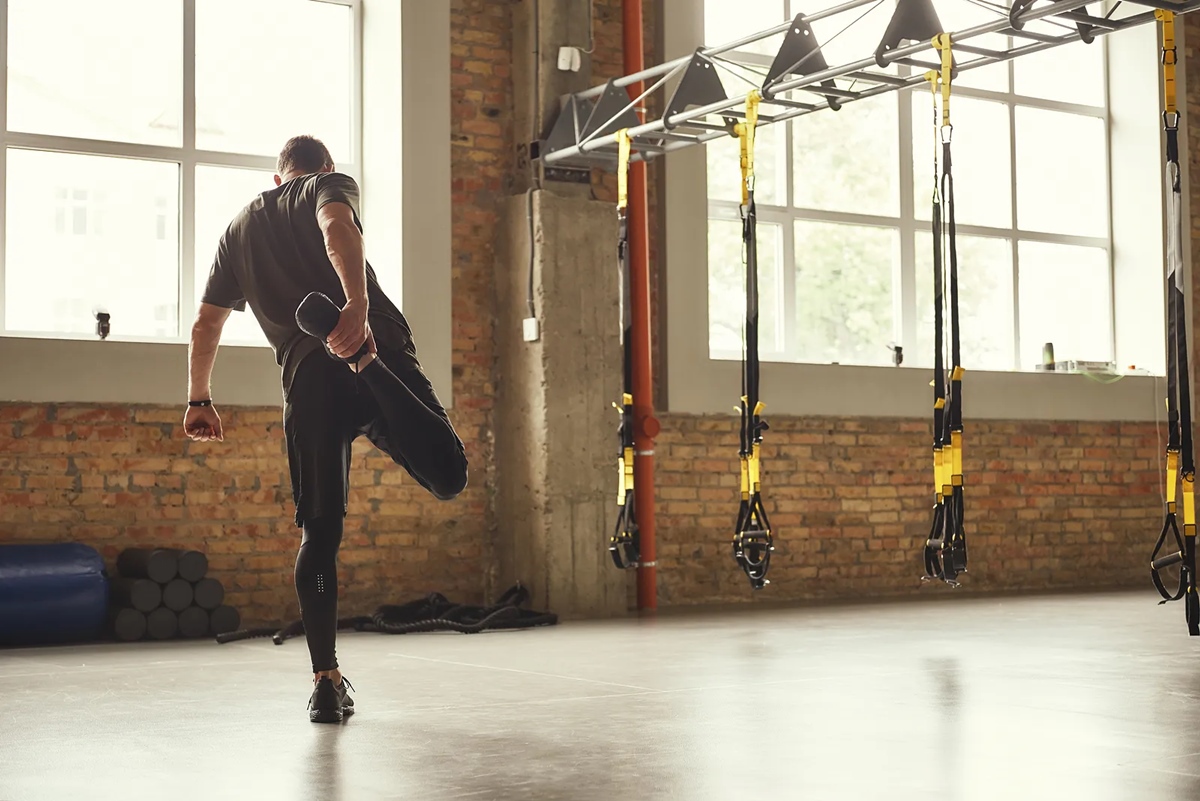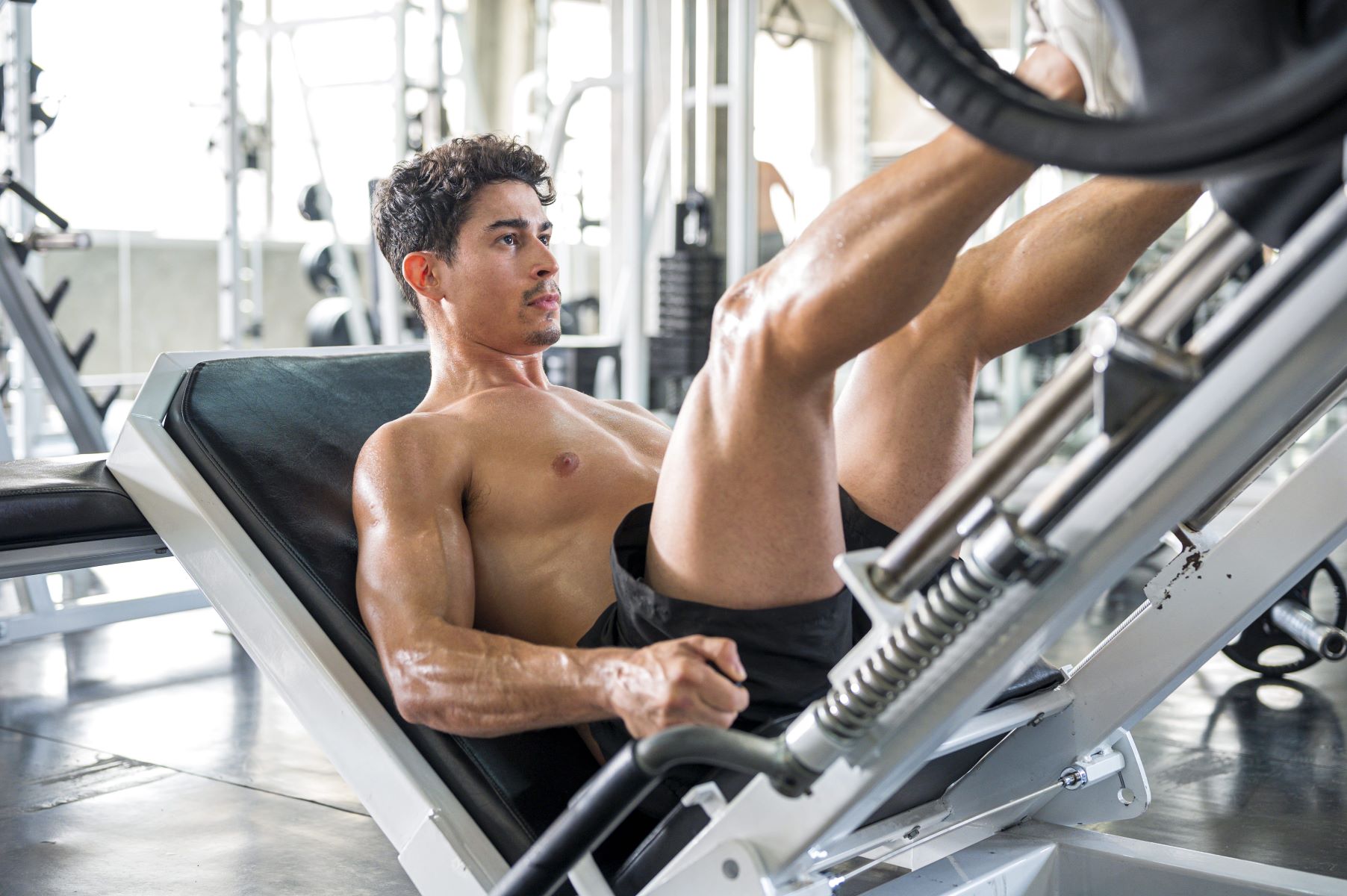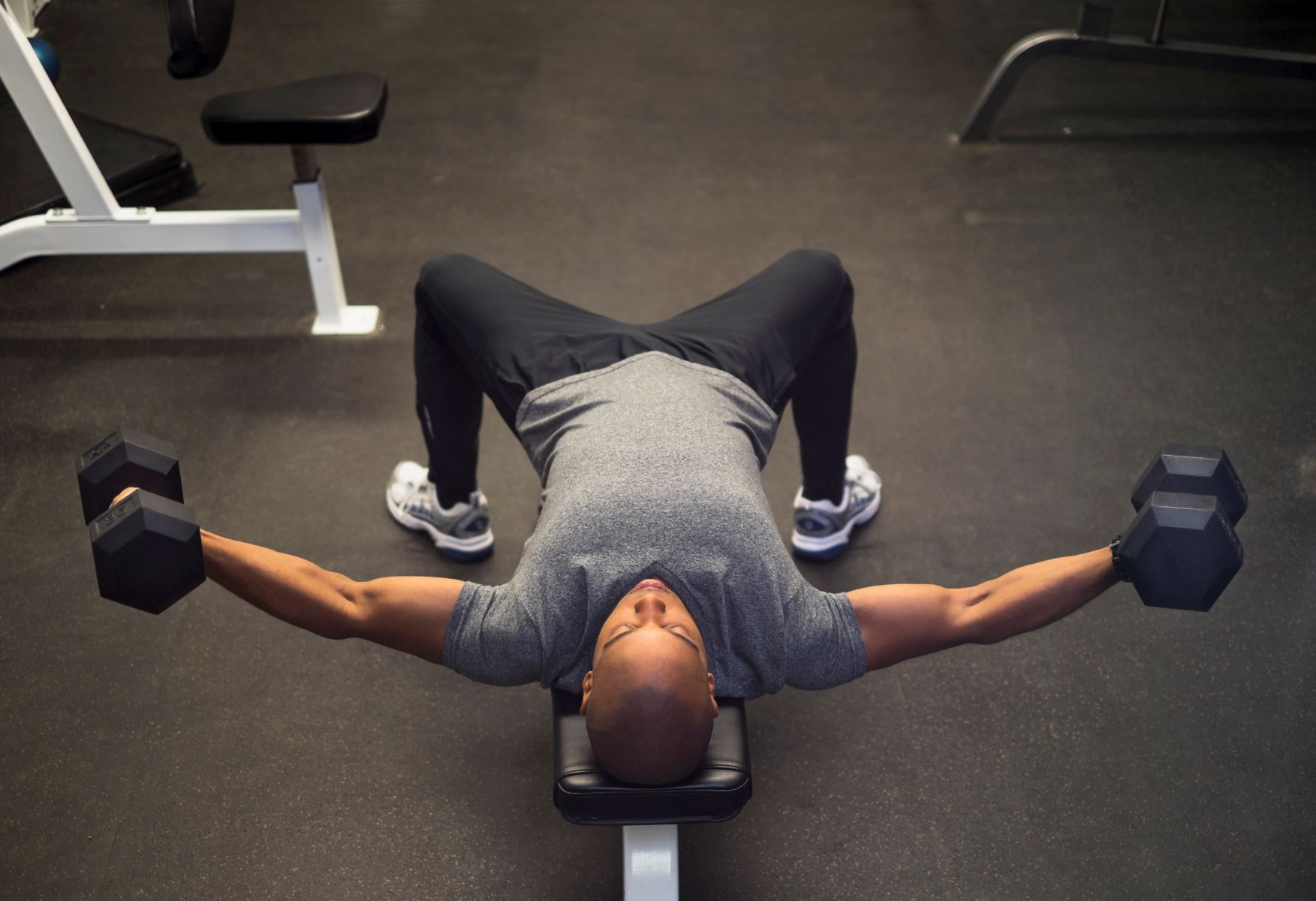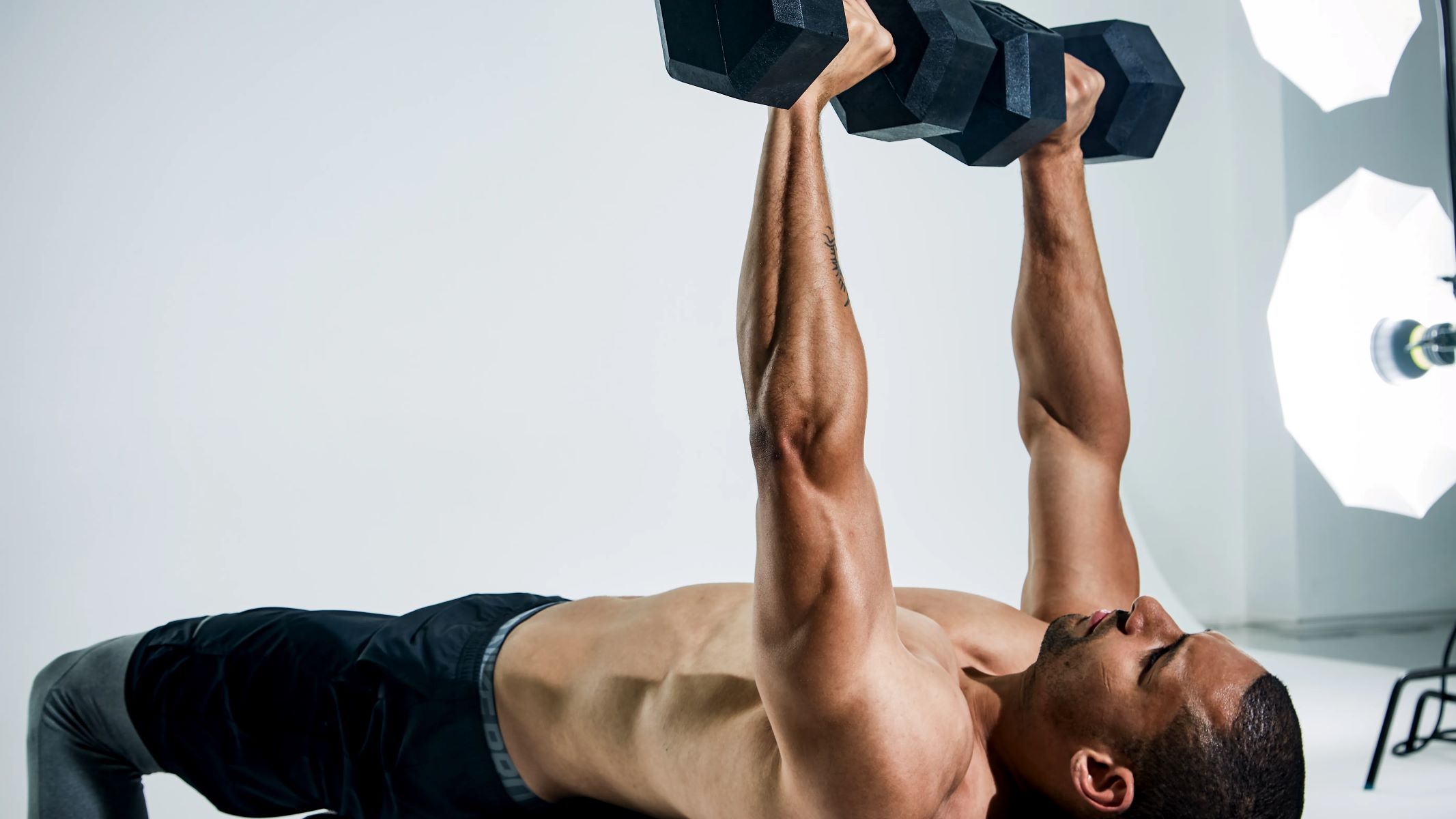

Featured
What Should You Workout With Chest
Modified: March 1, 2024
Looking to enhance your chest muscles? Discover the featured workout routines and exercises that will help you achieve a stronger and more defined chest.
Importance of Chest Workouts
Your chest muscles, scientifically known as the pectoralis major and minor, play a crucial role in your upper body strength and overall physique. Incorporating regular chest workouts into your fitness routine can offer a range of benefits, both aesthetically and functionally.
1. Strong and Defined Chest: One of the primary reasons people focus on chest exercises is to develop a strong and well-defined chest. A muscular chest not only adds to your aesthetic appeal but also gives you the confidence to flaunt your physique.
2. Upper Body Strength: Your chest muscles work in synergy with other upper body muscles such as the shoulders and arms. Building strength in your chest translates to improved performance in activities that involve pushing movements, such as bench pressing, push-ups, and lifting heavy objects.
3. Improved Posture: A weak chest can contribute to poor posture, leading to rounded shoulders and a hunched back. By strengthening your chest muscles, you can help correct posture imbalances, promoting a more upright, confident stance.
4. Enhanced Athletic Performance: Chest workouts are not just limited to bodybuilders or weight lifters. They are equally important for athletes involved in sports like swimming, boxing, basketball, and tennis, as a strong chest contributes to power, speed, and agility required in these activities.
5. Functional Fitness: Many daily activities, such as pushing a heavy object, carrying groceries, or even getting up from a lying position, depend on chest strength. By incorporating chest exercises into your routine, you can improve your functional fitness, making everyday tasks easier and reducing the risk of injury.
6. Hormonal Benefits: Engaging in intense chest workouts can stimulate the release of growth hormones, such as testosterone and human growth hormone (HGH). These hormones play a vital role in muscle growth, recovery, and overall well-being.
7. Balanced Upper Body Development: A well-rounded upper body includes strong and proportionate chest muscles. By neglecting chest exercises, you may create muscular imbalances and increase the risk of injuries, particularly in the shoulder and upper back regions.
To reap these benefits, it is essential to incorporate a variety of chest exercises into your workout routine. In the following sections, we will explore some of the most effective chest exercises and how to structure a comprehensive chest workout.
Top Chest Exercises
When it comes to chest workouts, there are numerous exercises that target the pectoral muscles from different angles and with varying degrees of intensity. Here are some of the top chest exercises that you can incorporate into your workout routine:
- Dumbbell Chest Press: This exercise targets the chest muscles while also engaging the shoulders and triceps. Lie on a bench with a dumbbell in each hand and press them upward until your arms are fully extended. Slowly lower the dumbbells back down to the starting position, maintaining control throughout the movement.
- Push-ups: A classic bodyweight exercise that effectively targets the chest muscles. Start in a plank position with your hands slightly wider than shoulder-width apart. Lower your body until your chest is close to the ground, then push back up to the starting position. To increase difficulty, elevate your feet or try different hand positions.
- Barbell Bench Press: This compound exercise is a staple in any chest workout routine. Lie on a flat bench with your feet firmly planted on the ground. Grasp the barbell with a grip slightly wider than shoulder-width apart. Lower the barbell to your chest, pause, and then press it back up to the starting position. Use a spotter for safety.
- Incline Dumbbell Press: This exercise targets the upper portion of the chest. Set an incline bench at a 45-degree angle and lie back with a dumbbell in each hand. With your palms facing forward, press the dumbbells upward until your arms are fully extended. Lower the dumbbells back down with control.
- Cable Flyes: Cable flyes isolate the chest muscles and provide constant tension throughout the movement. Stand between two cable pulleys, set at shoulder height. Grab a handle in each hand and step forward, with your arms extended out to the sides and slightly bent at the elbows. Bring your hands together in front of your chest, then slowly return to the starting position.
- Chest Dips: This exercise targets the chest, shoulders, and triceps. Use parallel bars or a dip station, gripping the handles with your palms facing inward. Lower your body by bending your elbows until your chest is at the same height as your hands, then push back up to the starting position.
- Pec Deck Machine: This machine exercise isolates the chest muscles. Sit on the machine with your back against the pad and grasp the handles with your elbows at a 90-degree angle. Bring the handles together in front of your chest, squeezing your chest muscles, and then slowly return to the starting position.
These exercises target different areas of the chest, allowing for balanced muscle development. Incorporate a mix of compound exercises, isolation exercises, and bodyweight exercises into your chest workouts for optimal results. Remember to maintain proper form and gradually increase the weight or difficulty level as you progress.
Dumbbell Chest Press
The dumbbell chest press is a highly effective exercise for strengthening and building your chest muscles. It targets the pectoralis major, as well as the shoulders and triceps. It can be performed either on a flat bench or an incline bench, depending on your preference and desired training emphasis.
Here’s how to properly perform the dumbbell chest press:
- Start by lying flat on a bench with a dumbbell in each hand. Hold the dumbbells at shoulder level, with your palms facing forward. Your feet should be flat on the ground for stability.
- Take a deep breath and engage your core muscles to stabilize your body throughout the exercise.
- Press the dumbbells upward until your arms are fully extended, but not locked out. This is your starting position.
- Lower the dumbbells slowly and with control, by bending your elbows and bringing them out to the sides. Keep your elbows at around a 45-degree angle from your body to target the chest muscles effectively. Keep lowering until the dumbbells are on either side of your chest, close to your shoulders.
- Pause for a brief moment at the bottom of the movement, then push the dumbbells back up to the starting position by extending your elbows. Exhale as you exert force to press the dumbbells.
- Repeat the movement for the desired number of repetitions. Aim for 8-12 repetitions per set to promote muscle growth and strength.
- Once you have completed your set, lower the dumbbells back to the starting position in a slow and controlled manner.
- Tips:
- Ensure that your back remains in contact with the bench throughout the exercise for stability and proper form.
- Keep your shoulders relaxed and avoid shrugging them up towards your ears. Maintain a stable position throughout the movement.
- Avoid locking out your elbows when extending your arms. This helps to keep tension on the muscles and reduces strain on the joints.
- Choose an appropriate weight that challenges your muscles while allowing you to maintain proper form. You may need to start with lighter weights and gradually increase the load as your strength improves.
The dumbbell chest press is a versatile exercise that can be modified to suit your fitness level and goals. Whether you are a beginner or an experienced lifter, incorporating dumbbell chest presses into your routine can help you develop a strong, well-defined chest. Remember to listen to your body, maintain proper form, and consult a fitness professional if you have any concerns about exercising safely and effectively.
Push-Ups
Push-ups are a classic and effective bodyweight exercise that primarily targets the chest muscles, but also engage the shoulders, triceps, and core muscles. This exercise can be performed anywhere and requires no equipment, making it a convenient and versatile choice for chest workouts.
Here’s how to properly perform push-ups:
- Begin in a plank position with your hands slightly wider than shoulder-width apart. Your hands should be directly under your shoulders, and your body should form a straight line from your head to your heels. Engage your core muscles to maintain stability.
- Lower your body towards the ground by bending your elbows, keeping them close to your torso. Keep your body straight and avoid sagging or arching your back.
- Continue lowering until your chest is close to or touches the ground. Ensure that you maintain control throughout the movement and avoid bouncing or jerking.
- Pause for a brief moment at the bottom of the movement, then push your body back up to the starting position by extending your elbows. Exhale as you exert force to push yourself up.
- Repeat the movement for the desired number of repetitions. Aim for 10-15 repetitions per set to challenge your muscles and build strength.
- Tips:
- Maintain proper form throughout the exercise. Keep your body straight and avoid sagging your hips or arching your back.
- Engage your core muscles by drawing your belly button towards your spine. This helps to stabilize your body and protect your lower back.
- Modify the exercise to suit your fitness level. If standard push-ups are too challenging, you can start with modified push-ups by keeping your knees on the ground. As you progress, gradually increase the difficulty by transitioning to full push-ups.
- Vary your hand positions to target different areas of the chest and engage different muscle groups. You can try wide grip push-ups, narrow grip push-ups, or diamond push-ups.
- Control your breathing throughout the exercise. Inhale as you lower your body, and exhale as you push back up.
Push-ups are a versatile exercise that can be integrated into your chest workout routine to build strength, endurance, and muscular definition in your chest muscles. Additionally, they offer the added benefit of engaging your core and upper body muscles, promoting overall upper body fitness. Whether you are a beginner or advanced fitness enthusiast, push-ups can be adjusted to suit your fitness level and allow for progressive overload. Incorporate push-ups into your workouts to enhance your chest training and overall upper body strength.
Barbell Bench Press
The barbell bench press is a fundamental compound exercise that is widely regarded as one of the best exercises for building a strong and well-developed chest. It primarily targets the pectoralis major muscles, but also engages the shoulders, triceps, and even the core muscles to a certain extent. This exercise can be performed on a flat bench and can be adjusted to fit various fitness levels and goals.
Here’s how to properly perform the barbell bench press:
- Lie flat on a bench with your feet planted firmly on the ground. Your back, shoulders, and buttocks should be in contact with the bench.
- Grasp the barbell with a grip that is slightly wider than shoulder-width apart. Your palms should be facing forward, and your wrists should be straight.
- Unrack the barbell by extending your arms fully. Keep the barbell positioned above your chest, in line with your eyes.
- Inhale and lower the barbell towards your chest by bending your elbows. Keep your elbows at around a 45-degree angle from your body to maximize chest engagement.
- Pause for a brief moment when the barbell lightly touches your chest. Maintain tension in your chest muscles.
- Exhale and push the barbell back up by extending your elbows. Generate force through your chest, shoulders, and arms to lift the weight.
- Repeat the movement for the desired number of repetitions. Aim for 8-12 repetitions per set to promote strength and muscle growth.
- Once you have completed your set, safely rack the barbell back onto the hooks.
- Tips:
- Use a spotter when performing heavy barbell bench presses to ensure safety and to assist in case you are unable to complete a repetition.
- Engage your core muscles throughout the exercise to maintain stability and prevent excessive arching of the back.
- Keep your shoulders relaxed and avoid shrugging them up towards your ears. This helps to maintain proper form and prevents unnecessary strain on the shoulder joints.
- Ensure a controlled descent of the barbell, focusing on the eccentric (lowering) phase of the movement as it puts additional stress on the muscle fibers and promotes muscle growth.
- Gradually increase the weight you lift as you progress in strength and technique. However, always prioritize proper form and technique over lifting heavier weights.
The barbell bench press is a staple exercise for chest development, strength, and power. Incorporating it into your routine can help you build a solid foundation of upper body strength and contribute to a well-defined chest. Remember to warm up adequately and start with lighter weights to practice proper form. Consult a fitness professional if you have any concerns about performing this exercise safely and effectively.
Incline Dumbbell Press
The incline dumbbell press is an excellent exercise that specifically targets the upper portion of the chest, also known as the clavicular head of the pectoralis major. By performing this exercise on an incline bench, you can isolate and stimulate the upper chest muscles, creating a well-rounded and balanced chest development.
Here’s how to properly perform the incline dumbbell press:
- Set an incline bench at a 45-degree angle and sit back, resting your back against the bench. Hold a dumbbell in each hand with an overhand grip.
- Position the dumbbells at shoulder level, with your palms facing forward. Your elbows should be bent and aligned with your shoulders.
- Press the dumbbells upward in a controlled manner, extending your arms fully. Ensure that the dumbbells are directly above your shoulders.
- As you lower the dumbbells, inhale and bend your elbows, bringing them out to the sides. Lower the dumbbells until your upper arms are slightly below parallel to the ground, feeling a stretch in your chest.
- Pause for a brief moment at the bottom of the movement, maintaining tension in your chest muscles.
- Exhale and push the dumbbells back up to the starting position, extending your elbows. Focus on contracting your chest muscles as you press the dumbbells.
- Repeat the movement for the desired number of repetitions. Aim for 8-12 repetitions per set to promote muscle growth and strength.
- Tips:
- Adjust the incline bench angle to target different areas of the chest. A higher incline focuses more on the upper chest, while a lower incline places more emphasis on the middle chest.
- Maintain proper form throughout the exercise. Keep your back against the bench and avoid arching it.
- Keep your shoulders relaxed and avoid shrugging them up. This helps to maintain stability and prevent strain on the shoulder joints.
- Engage your core muscles throughout the exercise to maintain stability and control.
- Choose dumbbells that allow you to complete the desired number of repetitions with proper form. Gradually increase the weight as your strength improves.
The incline dumbbell press provides an excellent way to target and develop the upper chest muscles, giving your chest a well-defined and balanced appearance. Incorporate this exercise into your chest workout routine to add variety and effectively work different areas of your chest. Remember to start with lighter weights to master proper form and technique before progressing to heavier weights. Consult a fitness professional if you have any concerns about performing this exercise safely and effectively.
Cable Flyes
Cable flyes are a highly effective exercise for targeting the chest muscles, providing constant tension throughout the movement. By using a cable machine, you can isolate and engage the chest muscles from different angles, resulting in a well-rounded and sculpted chest.
Here’s how to properly perform cable flyes:
- Set the cable pulleys to shoulder height, and stand in the center, facing away from the machine. Take a step forward with one foot for stability.
- Grasp a handle in each hand and extend your arms out to the sides, keeping a slight bend in your elbows. Your palms should be facing forward throughout the movement.
- Engage your core muscles and maintain a slight forward lean from your hips. This will ensure stability and proper alignment during the exercise.
- Bring your hands together in front of your chest, crossing them over each other in a controlled and deliberate manner. Focus on squeezing your chest muscles as you bring your hands together.
- Slowly release and return to the starting position, with your arms extended out to the sides. Keep a slight bend in your elbows throughout the movement to maintain muscle tension.
- Repeat the movement for the desired number of repetitions. Aim for 10-12 repetitions per set to promote muscle growth and strength.
- Tips:
- Use a weight that allows you to maintain proper form and control throughout the exercise. Avoid swinging or jerking movements.
- Maintain a slight bend in your elbows throughout the movement to minimize stress on the elbow joints.
- Focus on keeping your shoulders relaxed and avoid shrugging them up towards your ears. This helps to maintain proper form and prevents unnecessary strain on the shoulder joints.
- Control your breathing throughout the exercise. Inhale as you release the cables, and exhale as you bring your hands together.
- Experiment with different grip positions, such as using handles with neutral grips or rotating grips. This can help target different areas of the chest and provide variety to your workouts.
- Perform the cable flyes at a controlled tempo, focusing on the mind-muscle connection to maximize the effectiveness of the exercise.
Cable flyes are a versatile exercise that provides constant tension on the chest muscles throughout the entire range of motion, promoting muscle growth and definition. Incorporating this exercise into your chest workout routine will add variety and help you target different areas of your chest. Remember to start with lighter weights and gradually increase the resistance as your strength improves. Consult a fitness professional if you have any concerns about performing this exercise safely and effectively.
Chest Dips
Chest dips are a highly effective exercise for targeting the chest muscles, as well as the shoulders and triceps. This compound exercise can be performed using parallel bars or a dip station, and it allows for a deep stretch and contraction of the chest muscles, resulting in a sculpted and well-defined chest.
Here’s how to properly perform chest dips:
- Start by gripping the parallel bars or dip station with your hands placed slightly wider than shoulder-width apart. Your palms should be facing inward.
- With your arms fully extended, jump or step up to raise your body off the ground. Cross your feet and bend your knees if necessary to avoid dragging your feet.
- Lower your body by bending your elbows and leaning your torso forward. Continue lowering until your chest is at the same level or slightly below your hands. Keep your elbows in and your shoulders down and back.
- Pause for a brief moment at the bottom of the movement, feeling the stretch in your chest muscles.
- Exhale and push yourself back up by extending your elbows. Focus on squeezing your chest muscles as you return to the starting position.
- Repeat the movement for the desired number of repetitions. Aim for 8-12 repetitions per set to promote muscle growth and strength.
- Tips:
- Engage your core muscles throughout the exercise to maintain stability and control.
- Keep your shoulders relaxed and avoid shrugging them up towards your ears. This helps to maintain proper form and prevents unnecessary strain on the shoulder joints.
- If chest dips are too challenging, you can start with assisted dips using a resistance band or a dip machine. Gradually reduce the assistance as your strength improves.
- Control your breathing during the exercise. Inhale as you lower your body, and exhale as you push yourself back up.
- Focus on a slow and controlled tempo to maximize the effectiveness of the exercise and prevent any swinging or jerking motions.
- If you experience any pain or discomfort during chest dips, consult a fitness professional to ensure proper form and technique.
Chest dips are an advanced exercise that targets the chest muscles from a different angle, promoting muscle growth and strength. Incorporating chest dips into your chest workout routine will help you achieve a well-rounded and sculpted chest. Remember to start with proper form and progress at your own pace. Consult a fitness professional if you have any concerns about performing this exercise safely and effectively.
Pec Deck Machine
The pec deck machine, also known as the butterfly machine, is a popular piece of gym equipment designed to isolate and target the chest muscles. This machine provides stability and allows for controlled movements, making it an effective exercise for building strength and muscle definition in the chest.
Here’s how to properly use the pec deck machine:
- Sit on the machine with your back against the pad and adjust the seat height so that your elbows line up with the handles.
- Place your forearms on the padded lever handles, making sure your upper arms are parallel to the ground and your elbows are at a 90-degree angle.
- Engage your core muscles and press the handles together by squeezing your chest muscles. Keep your upper body stable throughout the movement.
- Hold the contraction for a brief moment, feeling the tension in your chest muscles.
- Release the handles and return to the starting position in a controlled manner, focusing on maintaining tension in the chest muscles.
- Repeat the movement for the desired number of repetitions. Aim for 8-12 repetitions per set to promote muscle growth and strength.
- Tips:
- Ensure that your back is firmly against the pad throughout the exercise to maintain stability and prevent unnecessary strain on the lower back.
- Maintain a slight bend in your elbows throughout the movement to keep tension on the chest muscles and reduce strain on the joints.
- Control your breathing during the exercise. Inhale as you release the handles, and exhale as you press them together.
- Focus on a slow and controlled tempo to maximize the effectiveness of the exercise and prevent any jerking or bouncing motions.
- Adjust the weight on the machine according to your strength and fitness level. Start with lighter weights and gradually increase the resistance as you become more comfortable and stronger.
- Include the pec deck machine as part of your overall chest workout routine. It can be used as a finishing exercise to fully exhaust the chest muscles after compound movements.
The pec deck machine provides a isolated and controlled movement for targeting the chest muscles. Incorporating this machine into your chest workout routine can help you build strength, increase muscle definition, and achieve a well-developed chest. Remember to maintain proper form, adjust the machine to fit your body proportions, and consult a fitness professional if you have any concerns about performing this exercise safely and effectively.
Common Mistakes to Avoid while Training Chest
When training the chest, it’s important to perform exercises with proper form and technique to maximize results and minimize the risk of injury. Avoiding these common mistakes will help you make the most of your chest workouts:
- Using Excessive Momentum: Swinging or jerking the weights can take the focus off the chest muscles and lead to ineffective workouts. Instead, prioritize slow and controlled movements to maintain tension on the muscles throughout the exercise.
- Neglecting Proper Warm-up: Failing to warm up before chest workouts can increase the risk of muscle strains and other injuries. Always allocate time to perform dynamic warm-up exercises and gradually increase the intensity before diving into heavier lifts.
- Lifting Excessive Weight: Proper form is paramount. Avoid lifting weights that are too heavy and compromise your form, as this can lead to injury. Focus on using a weight that allows you to maintain proper technique throughout the entire range of motion.
- Not Engaging the Mind-Muscle Connection: Mind-muscle connection is essential for targeting the chest muscles effectively. Concentrate on engaging the chest muscles and feeling the contraction during each repetition to maximize the benefits of the exercise.
- Neglecting Full Range of Motion: Partial reps or not using the full range of motion can limit muscle stimulation and hinder progress. Aim to perform exercises through a complete range of motion, ensuring a stretch at the bottom and contraction at the top of each repetition.
- Improper Breathing: Breathing plays a crucial role in maintaining stability and control during chest exercises. Avoid holding your breath and remember to exhale during the exertion phase and inhale during the relaxation phase of each repetition.
- Overtraining or Undertraining: Striking the right balance is important. Overtraining the chest by performing too many exercises or high-volume workouts can lead to muscle fatigue and hinder recovery. On the flip side, undertraining by skipping workouts or not challenging yourself enough can impede progress. Aim for appropriate frequency and intensity to stimulate muscle growth and allow for sufficient recovery.
- Neglecting Other Muscle Groups: While focusing on chest workouts is essential for chest development, neglecting other muscle groups can lead to imbalances and potential injuries. Ensure you maintain a well-rounded workout routine that includes exercises for all major muscle groups.
- Ignoring Proper Nutrition and Recovery: Building a strong and well-defined chest requires more than just workouts. Proper nutrition, including adequate protein intake, as well as sufficient rest and recovery, play crucial roles in muscle growth. Neglecting these factors can impede progress and hinder your chest development.
Avoiding these common mistakes will help you perform chest exercises correctly, enhance your progress, and reduce the risk of injury. Prioritize proper form, technique, and overall balanced training to maximize the benefits of your chest workouts. If you are unsure about the proper execution of exercises or the design of your workout routine, consult a qualified fitness professional for guidance.
How to Structure a Chest Workout Routine
Structuring an effective chest workout routine involves selecting a variety of exercises that target different areas of the chest and incorporating adequate volume and intensity. Here are some tips to help you design an efficient chest workout routine:
- Warm-Up: Begin each chest workout with a dynamic warm-up to prepare the muscles and joints for the upcoming exercises. This can include arm circles, shoulder rolls, and light sets of push-ups or chest stretches.
- Compound Movements: Start your chest workout with compound exercises that engage multiple muscle groups. These exercises include barbell bench press, dumbbell chest press, or chest dips. Perform 3-4 sets of 8-12 repetitions with challenging weights.
- Isolation Exercises: Follow compound movements with isolation exercises that target specific areas of the chest. This can include incline dumbbell press, cable flyes, or pec deck machine. Perform 2-3 sets of 10-15 repetitions with controlled movements and focus on the mind-muscle connection.
- Variety of Angles: Incorporate exercises that target different angles of the chest, such as incline, flat, and decline movements. This ensures overall chest development and prevents muscle imbalances.
- Progressive Overload: To stimulate muscle growth and strength, progressively increase the weight or resistance used over time. This gradual progression challenges the muscles and promotes continual adaptation.
- Superset or Drop Set: To increase the intensity and optimize your workout time, consider incorporating supersets or drop sets. These techniques involve performing exercises back-to-back with minimal rest or reducing the weight/resistance after reaching muscle failure.
- Core and Cardio: Add core exercises and cardiovascular activities to your chest workout routine. Strengthening the core muscles helps maintain stability during chest exercises, and cardio improves overall cardiovascular health and can aid in fat loss.
- Rest and Recovery: Allow sufficient time for rest and recovery between workouts to allow the muscles to repair and grow. Aim for at least 48 hours of rest before targeting the chest muscles again.
- Consistency: Consistency is key for progress. Aim to train the chest muscles at least twice a week to optimize muscle growth and development. However, listen to your body and adjust the frequency and intensity based on your individual recovery needs.
Remember, everyone’s fitness level and goals are different, so adjust your chest workout routine accordingly. Consulting a qualified fitness professional can provide personalized guidance and help create a routine that aligns with your specific needs and objectives. Stay consistent, challenge yourself, and maintain proper form to achieve optimal results from your chest workouts.
Frequency and Intensity of Chest Workouts
When it comes to training the chest muscles, finding the right balance of frequency and intensity is key for achieving optimal results. Both factors play a crucial role in muscle growth, strength gains, and overall chest development. Here’s what you need to know about frequency and intensity when designing your chest workout routine:
Frequency:
The recommended frequency of chest workouts depends on various factors, including your fitness level, recovery ability, and overall training volume. However, as a general guideline, training the chest muscles at least twice a week is recommended to promote muscle growth and progress.
By training your chest muscles more frequently, you provide them with consistent stimulation and create an environment for muscle adaptation. This can be achieved by splitting your training routine into specific muscle groups (e.g., upper body and lower body) or incorporating full-body workouts that target multiple muscle groups in each session.
Intensity:
The intensity of your chest workouts refers to the level of effort and resistance applied during the exercises. It plays a significant role in challenging your muscles and promoting growth and strength gains.
To optimize the intensity of your chest workouts, consider the following factors:
- Weight Selection: Choose a weight or resistance that allows you to complete the desired number of repetitions with proper form while still challenging your muscles. Gradually increase the weight or resistance as your strength improves to continue progressing.
- Training Techniques: Incorporate different training techniques to increase intensity. These can include drop sets, supersets, rest-pause sets, or tempo variations. These techniques challenge the muscles in different ways, leading to increased muscle activation and growth.
- Volume: Volume, which refers to the total number of sets and repetitions performed, is another factor that affects intensity. As you become more experienced and adapted to training, gradually increase the volume by adding more sets or increasing the number of repetitions within each set.
- Progressive Overload: Progressive overload is crucial to continually challenge your muscles and drive progress. This involves gradually increasing the demands placed on your chest muscles over time. This can be achieved by lifting heavier weights, performing more repetitions, or reducing rest periods between sets.
It’s important to note that the intensity of your chest workouts should be customized to your fitness level and individual capabilities. Push yourself, but always listen to your body and avoid overexertion or sacrificing proper form to lift heavier weights. Consult with a fitness professional to ensure you are training at the appropriate intensity and to receive personalized guidance tailored to your specific goals and needs.
Precautions and Tips for Chest Workouts
While chest workouts can be highly effective for building strength and muscle mass, it’s important to approach them with proper precautions and techniques to ensure safety and maximize results. Here are some precautions and tips to keep in mind when performing chest exercises:
- Warm-Up: Always begin your workout with a proper warm-up, including dynamic movements and light cardio to increase blood flow to the muscles and prepare the body for the upcoming workout. This helps reduce the risk of injury and improves overall performance.
- Proper Technique and Form: Focus on maintaining proper technique and form throughout each exercise. This includes keeping your back flat, shoulders relaxed, and avoiding excessive arching of the lower back. Maintaining control and using a full range of motion ensures effective muscle activation and reduces the risk of strain or injury. If you’re unsure about proper form, consider working with a qualified fitness professional.
- Gradual Progression: It’s important to gradually progress in terms of weight and intensity. Avoid jumping to heavy weights that compromise your form and lead to potential injuries. Gradually increase the weight as your strength and technique improve to ensure consistent progress.
- Listen to Your Body: Pay attention to any signs of pain, discomfort, or unusual sensations during your chest workouts. If you experience any discomfort, stop the exercise and assess the situation. Pushing through pain can lead to injuries, so it’s important to listen to your body and respect its signals.
- Breathing: Proper breathing is essential for maintaining stability and providing oxygen to your muscles during exercise. Inhale during the relaxation phase and exhale forcefully during the exertion phase of each repetition. This helps brace your core and provides the necessary support for your chest exercises.
- Rest and Recovery: Allow for adequate rest and recovery between workouts. Overtraining can lead to muscle fatigue, decreased performance, and increased risk of injury. Aim for at least 48 hours of recovery time for your chest muscles before targeting them again.
- Variety and Balance: Incorporate a variety of exercises that target different areas of the chest (upper, middle, and lower) to achieve balanced muscle development. Also, include exercises that engage other muscle groups to avoid imbalances and promote overall strength and stability.
- Importance of Nutrition: Support your chest workouts with a balanced and nutritious diet. Ensure you’re consuming enough protein to aid in muscle repair and growth. Stay well-hydrated and fuel your body with the right nutrients to optimize your performance and recovery.
- Seek Professional Guidance: If you’re new to chest workouts or have specific concerns or limitations, consider seeking guidance from a qualified fitness professional. They can provide personalized advice, help you with proper exercise selection and form, and create a safe and effective workout plan tailored to your goals and abilities.
By following these precautions and tips, you can reduce the risk of injury and maximize the effectiveness of your chest workouts. Remember to prioritize safety, proper form, and patience on your fitness journey to achieve long-term progress and maintain a healthy and strong chest.
Conclusion
Chest workouts play a vital role in developing a strong, well-defined chest and improving overall upper body strength and aesthetics. Incorporating a variety of exercises, including dumbbell chest presses, push-ups, barbell bench presses, incline dumbbell presses, cable flyes, and chest dips, can target different areas of the chest and provide a well-rounded workout.
When performing these exercises, it is important to maintain proper form, gradually increase intensity and weight, and listen to your body. Avoid common mistakes like using excessive momentum, neglecting proper warm-up, lifting excessive weight, and not engaging the mind-muscle connection. By following precautions, such as warming up adequately, using proper technique, and paying attention to your body’s signals, you can safely and effectively train your chest muscles.
Structuring a chest workout routine involves combining compound and isolation exercises, targeting different angles, progressively increasing the intensity, incorporating supersets or drop sets, and ensuring proper rest and recovery. Balancing frequency and intensity is vital for optimal muscle growth and strength gains. Aim for at least two chest workouts per week, progressively challenging your muscles with the appropriate weight and resistance.
Remember to prioritize overall fitness and wellness by including core exercises, cardiovascular activities, and maintaining a nutritious diet. Proper nutrition and rest are crucial for supporting muscle growth and recovery, so fuel your body with the right nutrients and allow enough time for rest and recovery between workouts.
Incorporating these tips and techniques into your chest workout routine will help you achieve significant progress, develop a well-defined chest, improve upper body strength, and enhance your overall physique. Always prioritize safety, consult a fitness professional if needed, and enjoy the journey as you work towards your chest training goals.
